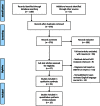A Systematic Review and Meta-analysis of Neuroimaging in Oppositional Defiant Disorder (ODD) and Conduct Disorder (CD) Taking Attention-Deficit Hyperactivity Disorder (ADHD) Into Account
- PMID: 26846227
- PMCID: PMC4762933
- DOI: 10.1007/s11065-015-9315-8
A Systematic Review and Meta-analysis of Neuroimaging in Oppositional Defiant Disorder (ODD) and Conduct Disorder (CD) Taking Attention-Deficit Hyperactivity Disorder (ADHD) Into Account
Abstract
Oppositional defiant disorder (ODD) and conduct disorder (CD) are common behavioural disorders in childhood and adolescence and are associated with brain abnormalities. This systematic review and meta-analysis investigates structural (sMRI) and functional MRI (fMRI) findings in individuals with ODD/CD with and without attention-deficit hyperactivity disorder (ADHD). Online databases were searched for controlled studies, resulting in 12 sMRI and 17 fMRI studies. In line with current models on ODD/CD, studies were classified in hot and cool executive functioning (EF). Both the meta-analytic and narrative reviews showed evidence of smaller brain structures and lower brain activity in individuals with ODD/CD in mainly hot EF-related areas: bilateral amygdala, bilateral insula, right striatum, left medial/superior frontal gyrus, and left precuneus. Evidence was present in both structural and functional studies, and irrespective of the presence of ADHD comorbidity. There is strong evidence that abnormalities in the amygdala are specific for ODD/CD as compared to ADHD, and correlational studies further support the association between abnormalities in the amygdala and ODD/CD symptoms. Besides the left precuneus, there was no evidence for abnormalities in typical cool EF related structures, such as the cerebellum and dorsolateral prefrontal cortex. Resulting areas are associated with emotion-processing, error-monitoring, problem-solving and self-control; areas associated with neurocognitive and behavioural deficits implicated in ODD/CD. Our findings confirm the involvement of hot, and to a smaller extent cool, EF associated brain areas in ODD/CD, and support an integrated model for ODD/CD (e.g. Blair, Development and Psychopathology, 17(3), 865-891, 2005).
Keywords: ADHD; ALE meta-analysis; CD; Functional MRI; ODD; Structural MRI.
Figures




Similar articles
-
Atypical antipsychotics for disruptive behaviour disorders in children and youths.Cochrane Database Syst Rev. 2012 Sep 12;(9):CD008559. doi: 10.1002/14651858.CD008559.pub2. Cochrane Database Syst Rev. 2012. Update in: Cochrane Database Syst Rev. 2017 Aug 09;8:CD008559. doi: 10.1002/14651858.CD008559.pub3. PMID: 22972123 Updated.
-
The pharmacological management of oppositional behaviour, conduct problems, and aggression in children and adolescents with attention-deficit hyperactivity disorder, oppositional defiant disorder, and conduct disorder: a systematic review and meta-analysis. Part 1: psychostimulants, alpha-2 agonists, and atomoxetine.Can J Psychiatry. 2015 Feb;60(2):42-51. doi: 10.1177/070674371506000202. Can J Psychiatry. 2015. PMID: 25886655 Free PMC article.
-
The pharmacological management of oppositional behaviour, conduct problems, and aggression in children and adolescents with attention-deficit hyperactivity disorder, oppositional defiant disorder, and conduct disorder: a systematic review and meta-analysis. Part 2: antipsychotics and traditional mood stabilizers.Can J Psychiatry. 2015 Feb;60(2):52-61. doi: 10.1177/070674371506000203. Can J Psychiatry. 2015. PMID: 25886656 Free PMC article.
-
Unique versus shared neural correlates of externalizing psychopathology in late childhood.J Psychopathol Clin Sci. 2024 Aug;133(6):477-488. doi: 10.1037/abn0000923. Epub 2024 Jun 13. J Psychopathol Clin Sci. 2024. PMID: 38869879 Free PMC article.
-
Parent training interventions for Attention Deficit Hyperactivity Disorder (ADHD) in children aged 5 to 18 years.Cochrane Database Syst Rev. 2011 Dec 7;2011(12):CD003018. doi: 10.1002/14651858.CD003018.pub3. Cochrane Database Syst Rev. 2011. PMID: 22161373 Free PMC article.
Cited by
-
Striatal connectopic maps link to functional domains across psychiatric disorders.Transl Psychiatry. 2022 Dec 13;12(1):513. doi: 10.1038/s41398-022-02273-6. Transl Psychiatry. 2022. PMID: 36513630 Free PMC article.
-
Irritability Is Associated With Decreased Cortical Surface Area and Anxiety With Decreased Gyrification During Brain Development.Front Psychiatry. 2021 Sep 22;12:744419. doi: 10.3389/fpsyt.2021.744419. eCollection 2021. Front Psychiatry. 2021. PMID: 34630188 Free PMC article.
-
Distinguishing Adolescents With Conduct Disorder From Typically Developing Youngsters Based on Pattern Classification of Brain Structural MRI.Front Hum Neurosci. 2018 Apr 23;12:152. doi: 10.3389/fnhum.2018.00152. eCollection 2018. Front Hum Neurosci. 2018. PMID: 29740296 Free PMC article.
-
Prevalence and comorbidity of attention deficit hyperactivity disorder in Chinese school-attending students aged 6-16: a national survey.Ann Gen Psychiatry. 2025 Apr 13;24(1):23. doi: 10.1186/s12991-025-00558-w. Ann Gen Psychiatry. 2025. PMID: 40223102 Free PMC article.
-
Assessing general versus specific liability for externalizing problems in adolescence: Concurrent and prospective prediction of symptoms of conduct disorder, ADHD, and substance use.J Psychopathol Clin Sci. 2022 Oct;131(7):793-807. doi: 10.1037/abn0000743. J Psychopathol Clin Sci. 2022. PMID: 36222627 Free PMC article.
References
-
- American Psychiatric Association (2013) Diagnostic and statistical manual of mental disorders: DSM-5, 5th edn. Arlington: American Psychiatric Publishing, Inc.
-
- Anderson VA, Jacobs R, Anderson PJ. Executive functions and frontal lobes: A lifespan perspective. Hove: Psychology Press; 2008.
Publication types
MeSH terms
LinkOut - more resources
Full Text Sources
Other Literature Sources
Medical

